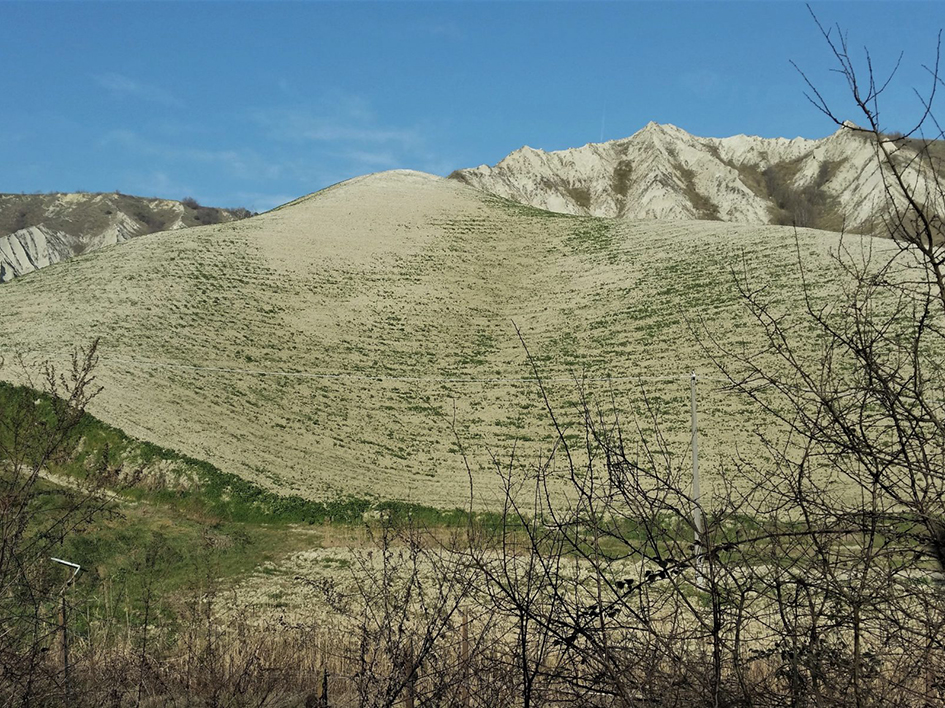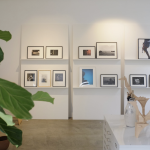english below
“Argille Azzurre”
Doppia intervista
Barbara De Ponti / Paolo Antonio Zambianchi
__
Confinis
progetto a cura di Marco Tagliafierro
__
E’ proprio vero che la Geologia è la più romantica delle scienze?
Le scienza della Terra possono contemplare dissolvenze con contesti umanistici?
Se siamo i nostri incontri, le nostre relazioni si possono rivelare germinative?
Queste alcune delle questioni che questo confronto sul confine
pone allo scopo di individuare nuove possibilità
per la gestione di un archivio interdisciplinare.
BDP – Sei un geologo: la mia visione della Geologia la pone come la più romantica tra le scienze. Mi sono costruita questa opinione considerando l’ambito molto ampio del vostro sapere che prevede anche conoscenze umanistiche o, forse, mi condiziona maggiormente conoscere la tua personale formazione che include studi classici?
PAZ – Il geologo è laureato in scienze della Terra, una disciplina che include tutti gli elementi e i processi che costituiscono il nostro pianeta, e non solo, quali le rocce, il suolo, l’atmosfera, l’acqua. Solo dopo l’esame di stato, chi decide di fare la professione del geologo, utilizza sul campo gli elementi specifici della geologia applicata all’ingegneria partendo da una preparazione di base sulla fisica, chimica e matematica. Quindi una serie complessa di dati scientifici da considerare contemporaneamente. La multidisciplinarietà di questa scienza “giovane” non le ha permesso, se non in tempi recenti grazie anche allo sviluppo delle nuove tecnologie, di riuscire a spiegare attraverso modelli e formule alcuni dei principali fenomeni e meccanismi della terra. Prima ci si ‘limitava’ ad attente osservazioni dei processi naturali cercando di intuirne romanticamente alcuni meccanismi. Ancora oggi, nell’immaginario collettivo, l’attività del geologo-tipo risulta più simile alle esperienze fascinose che fece Darwin agli inizi del 1800, raggiungendo mete esotiche con viaggi avventurosi o, all’opposto, a una figura mitologica a metà strada tra uno sciamano e un rabdomante. Conoscendo il tuo lavoro, mi ha incuriosito trovare una pratica artistica che include la collaborazione di professionisti di vari settori, spesso scientifici, creando relazioni germinative.
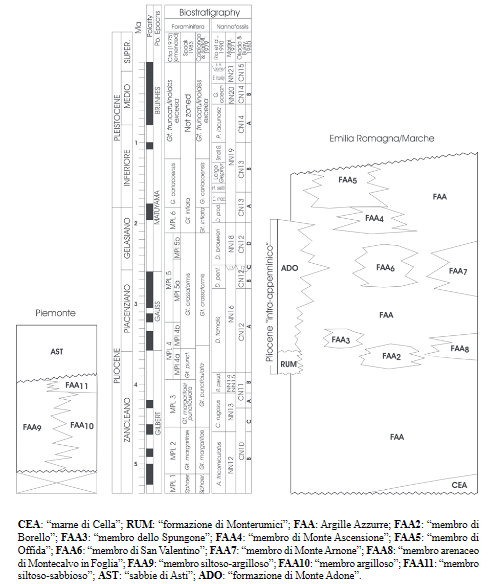
Biostratigrafia Argille Azzurre
BDP – Siamo i nostri incontri. La filosofia, la sociologia, e oggi anche studi sul marketing (questo per far capire quanto sia concreta questa affermazione), si sono espressi su questo argomento e la mia è una convinzione profonda che cerco di applicare il più possibile nel mio lavoro e nella vita privata, spesso intrecciandoli. Sono nati così i progetti degli ultimi quindi anni. Collaborazioni professionali e relazioni sociali uniti a studi storici e scientifici anche presso fondi archivistici. Era arrivato il momento di affrontare quello geologico. Come descriveresti un archivio geologico?
PAZ – Ogni porzione di terreno costituisce un archivio geologico, come un linguaggio che si stratifica nel tempo, in cui sono condensate informazioni universalmente codificate che permettono agli addetti la lettura della geocronologia, della polarità e delle biozone.
Ogni porzione di terreno costituisce un archivio geologico,
come un linguaggio che si stratifica nel tempo…
Quando per il tuo progetto Clay Time Code hai scelto il contesto faentino è stata necessaria la collaborazione con il paleontologo Dott. Luca Santucci per indagare le autoctone Argille Azzurre.
Cosa ti ha portato a scegliere di lavorare a Faenza con la ceramica se non sei una ceramista?
BDP – L’arte si è da sempre interessata a questioni legate alla natura del tempo. Riflettevo sul fatto che con l’argilla modellata si possa creare un’opera con un materiale che si è formato intorno ai 4,5 milioni di anni fa.
Riflettevo sul fatto che con l’argilla modellata si possa creare un’opera
con un materiale che si è formato intorno ai 4,5 milioni di anni fa.
Faenza, conosciuta come una delle capitali mondiali della ceramica, non sarebbe Faenza senza questa materia prima. Sono abituata a sentir parlare di argomenti geologici avendo tra i nostri più cari amici una schiera di professionisti del settore ed è stata l’occasione per lavorare con loro oltre che con te. Ho parlato con il dott. Luca Santucci che mi ha fornito numerosi spunti su cui riflettere. Mi ha colpito come nella geologia si usino spesso le immagini di fossili, i nannofossili marker, o meglio le loro icone, come strumenti indiretti per datare il tempo. Il tempo geologico, il tempo lunghissimo, profondissimo di Kronos, il mitologico titano figlio dell’unione tra Gea, la Terra, e Urano, il Cielo stellato, il firmamento fecondo. Ecco che ritorna la cultura classica associata alla geologia.
Da professionista che relazione trovi tra la tua scienza e il tempo?
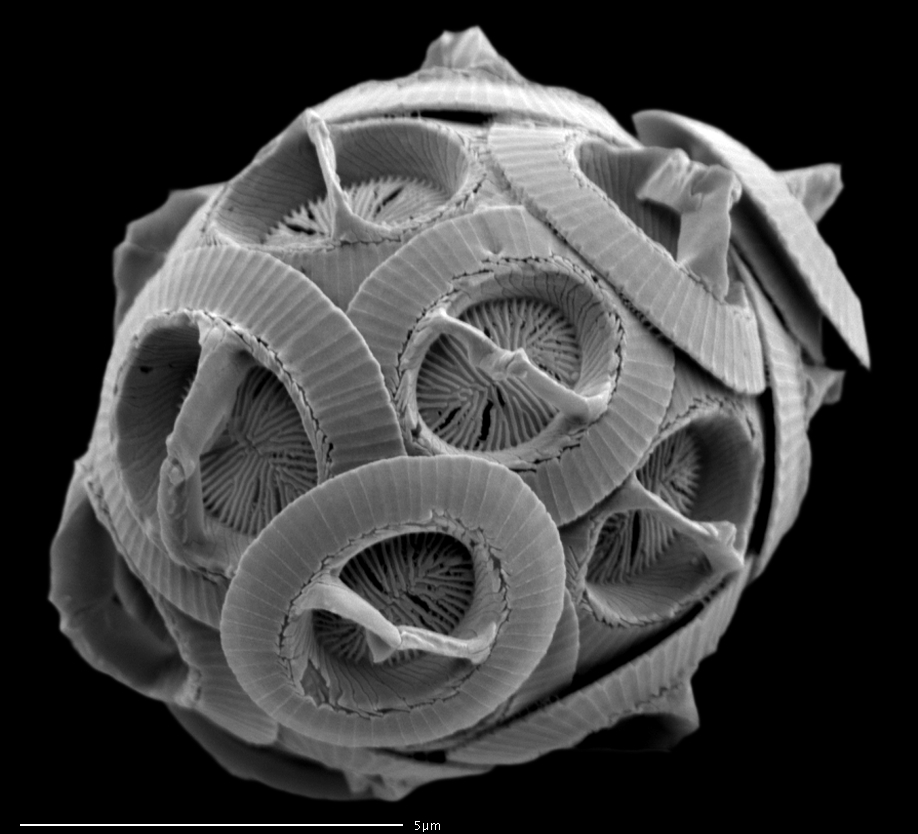
Gephyrocapsa oceanica
PAZ – Il contributo che la geologia, lo studio moderno sistematico delle scienze della terra, ha dato all’umana comprensione è stato allargare la scala temporale di riferimento: scientificamente non è più legata al rapporto con il tempo della vita di un uomo; ce lo fanno comprendere, ad esempio, i circa quattromilacinquecento milioni di anni con cui si stima l’età della Terra. Quindi l’uomo non è più metro di riferimento ma è comunque lui a studiare e a scegliere il linguaggio per comunicare i risultati di tale studio. Mi sembra che in Clay Time Code si affrontino entrambe i concetti.
BDP – Cito lo storico dell’arte Alessandro Castiglioni nella conversazione che ha avuto con te e che completa la ricerca esposta nella sede del Museo Carlo Zauli di Faenza: “Esiste una sorta di concorso nella costruzione del contenuto, dato in parte da noi che guardiamo il lavoro e in parte dalle motivazioni con cui è nato il lavoro; questo progetto nasce per stimolare una riflessione su quello che possiamo dire sul tempo e su quanto questi piccolissimi organismi antichissimi e estinti possano dire su di noi”.
“Esiste una sorta di concorso nella costruzione del contenuto,
dato in parte da noi che guardiamo il lavoro e in parte dalle motivazioni con cui è nato il lavoro;
questo progetto nasce per stimolare una riflessione su quello che possiamo dire sul tempo
e su quanto questi piccolissimi organismi antichissimi e estinti possano dire su di noi”.
Con il paleontologo abbiamo selezionato un foraminifero monocellulare la Globorotalia Puncticulata e un’alga planctonica la Gephyrocapsa Oceanica, estinti. Attraverso le loro immagini scattate al microscopio a scansione sono stata in grado di riprodurre tridimensionalmente gli organismi che determinano l’inizio e la fine del periodo geologico in cui si sono sedimentate le argille e di farlo usando le argille stesse che li contengono. Sculture di oltre un metro sono divenute dei grandi simulacri degli organismi microscopici. E’ sempre la mente umana a porsi quesiti che riguardano anche il fuori da se ma il suggerimento che vorrei arrivasse da questo lavoro è di limitare l’antropocentrismo.
E’ sempre la mente umana a porsi quesiti che riguardano anche il fuori da se
ma il suggerimento che vorrei arrivasse da questo lavoro è di limitare l’antropocentrismo.
Il lavoro affronta quesiti assoluti; è stato anche la base per un dialogo sulla valenza della forma con l’artista Jens Risch in una mostra promossa e organizzata dalla Galleria Viasaterna a Milano, ma poteva essere realizzato solo a Faenza, e non unicamente per una questione geologica.
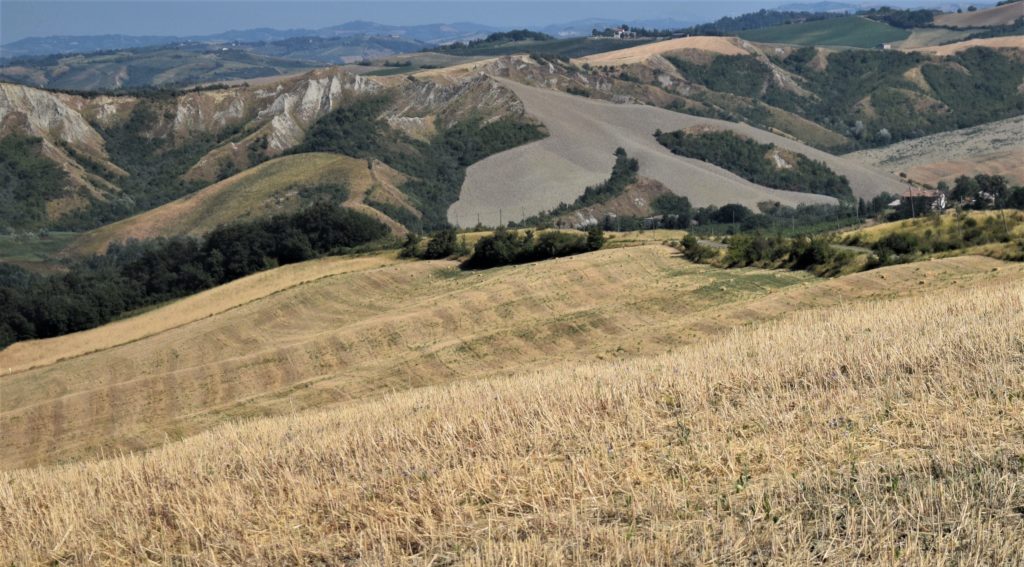
Calanchi, Faenza in prossimita della valle del fiume Lamone
PAZ – I fossili marker che hai scelto trovano una correlazione con la datazione assoluta del tempo cronologico nell’ambiente dove tali fossili hanno vissuto ed sono rimasti conservati. Non è un caso che una sede espositiva del progetto sia stata il Museo di Scienze Naturali Malmerendi di Faenza. Nello specifico la sua collezione di fossili provenienti dai calanchi locali, è una vera macchina del tempo che racconta la natura antica e marina di questi organismi. Il museo conserva e ancora raccoglie testimonianze del mare plio-pleistocenico che ricopriva il territorio il cui fondale, dopo evoluzioni tettoniche, sarà osservato e descritto da Leonardo da Vinci nei primi anni del Cinquecento col termine usato ancora oggi Argille Azzurre, come si legge nel codice Leichester. La relazione col territorio si è stretta anche grazie al convegno organizzato contestualmente dall’associazione Anepla e dall’Ordine dei Geologi dell’Emilia Romagna dal titolo Argille una risorsa tra arte e territorio, ospitato dal Museo Internazionale della Ceramica. Gli argomenti trattati si intrecciano fortemente con quanto proposto da Clay Time Code, che mostra quanto l’esperienza dell’arte si possa riversare sulla nostra esperienza del quotidiano uscendo dalle strutture linguistiche codificate. E poi abbiamo nuove preziose amicizie.
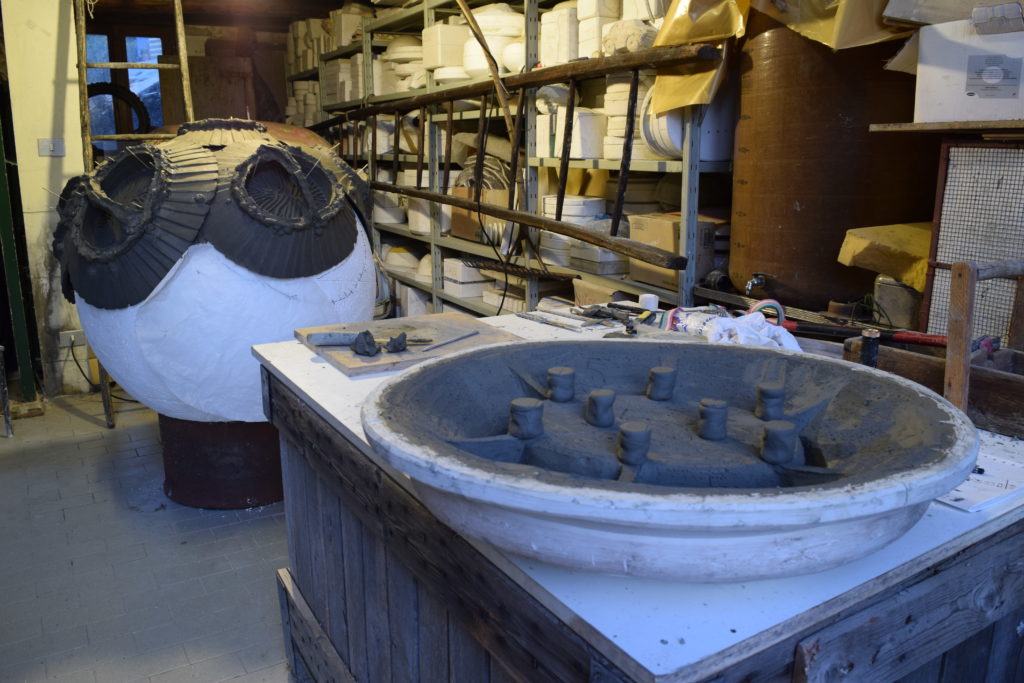
Barbara De Ponti, Clay Time Code, Gephyrocapsa Oceanica,2016, In Fieri
BDP – Sono gli strabilianti ceramisti che hanno permesso che le nostre idee si concretizzassero in oggetti di grande difficoltà tecnica e bellissimi, Aida Bertozzi e Ceramiche Sottosasso di Lorella Morgantini e Marco Malavolti. In modo molto professionale hanno sposato gli intenti del progetto e poi hanno adottato anche noi.
Sono gli strabilianti ceramisti che hanno permesso che le nostre idee
si concretizzassero in oggetti di grande difficoltà tecnica e bellissimi,
Aida Bertozzi e Ceramiche Sottosasso di Lorella Morgantini e Marco Malavolti.
In modo molto professionale hanno sposato gli intenti del progetto
e poi hanno adottato anche noi.
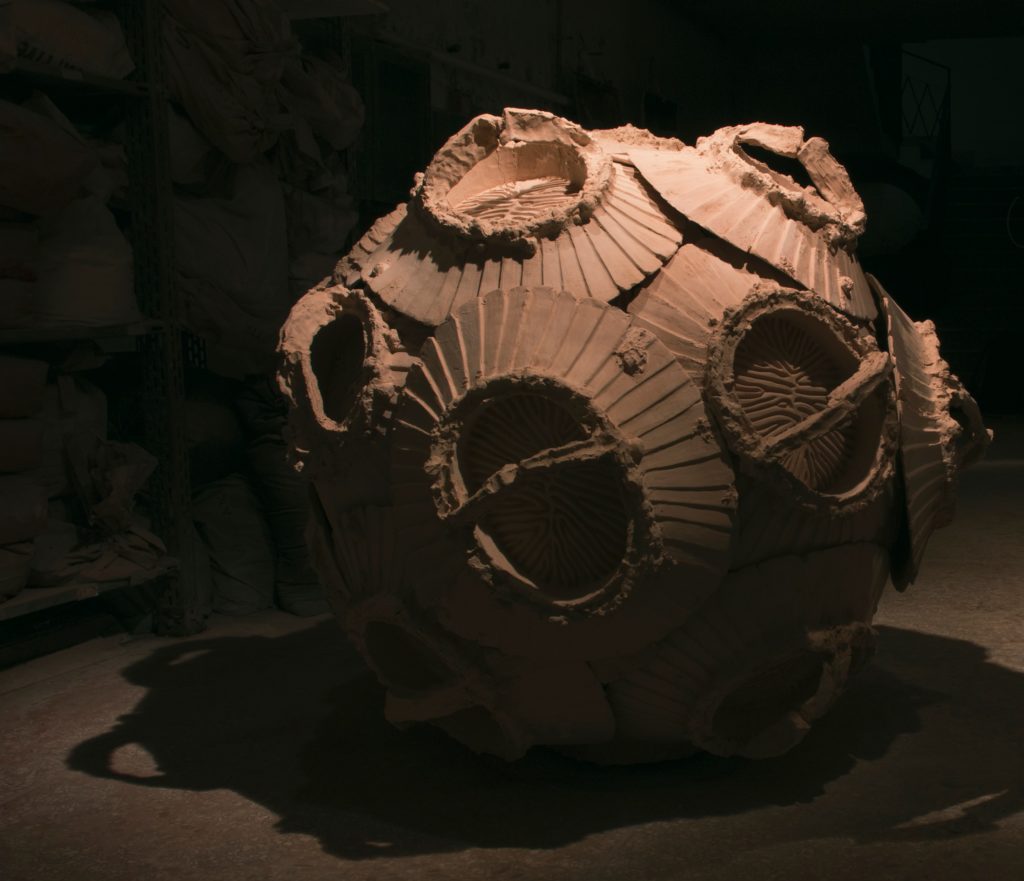
Barbara De Ponti, Clay Time Code, Gephyrocapsa Oceanica, Museo Zauli, 2016
“Blue Clays”
conversation between
Barbara De Ponti / Paolo Antonio Zambianchi
__
Confinis
project by Marco Tagliafierro
__
Is it really true that geology is the most romantic of the sciences?
Can Earth sciences contemplate blending into a framework of the humanities?
If we are our encounters, can our relationships sow important seeds?
These are some of the questions raised by this meeting of boundaries
in order to identify new possibilities for the management of an interdisciplinary archive.
BDP – You are a geologist: my vision of geology places it as the most romantic of the sciences. I have built this opinion considering the very broad scope of your knowledge which also includes the humanities; although perhaps what has the greatest impact on me is the knowledge that your personal training also includes study of the classics?
PAZ – The geologist has a degree in Earth sciences, a discipline that includes all the elements and processes that make up our planet and beyond, such as rocks, soil, atmosphere, water. It’s only after the state exam that those who decide to take up geology as a profession make use the specific elements of geology as they apply to the field of engineering, starting from a basic preparation in physics, chemistry and mathematics. Hence, a complex series of scientific data to be considered simultaneously. The multidisciplinary nature of this “young” science did not allow it to be able to explain some of the main phenomena and mechanisms of the earth through models and formulas until recent times, thanks to the development of new technologies. Previously we were ‘limited’ to careful observations of natural processes, trying to intuit some mechanisms in a romantic manner. Even today, in the collective imagination, the activity of the geologist-guy is more similar to the fascinating experiences that Darwin had in the early 1800s, reaching exotic destinations with adventurous journeys or, on the contrary, to a mythological figure midway between a shaman and a diviner. Knowing your work, I was intrigued to find an artistic practice that includes co-operation between professionals from various sectors, often scientific, creating germinative relationships.

Biostratigrafia Argille Azzurre
BDP – We are our encounters. Philosophy, sociology, and today also studies on marketing (this to make it clear how solid this statement is), have expressed themselves on this topic and mine is a deep conviction that I try to apply as much as possible both in my work and in my private life, often intertwining them. This gave rise to the projects of the last fifteen years. Professional collaborations and social relations combined with historical and scientific studies including archives. It was time to tackle the geological issue.
How would you describe a geological archive?
PAZ – Every piece of land constitutes a geological archive, like a language that is stratified over time, in which universally coded information is condensed, which allows the operators to read the geochronology, polarity and biozones.
Every piece of land constitutes a geological archive,
like a language that is stratified over time…
When for your project Clay Time Code you chose the Faenza context, it was necessary to work together with the palaeontologist Dr. Luca Santucci to investigate the native Blue Clays.
What led you to choose to work in Faenza with ceramics if you are not a potter?
BDP – Art has always been interested in issues related to the nature of time. I reflected on the fact that with modelled clay it is possible to create a work with a material that was formed around 4.5 million years ago.
I reflected on the fact that with modelled clay it is possible to create a work
with a material that was formed around 4.5 million years ago.
Faenza, known as one of the world capitals of ceramics, would not be Faenza without this raw material. I am used to hearing about geological topics, since a group of professionals in the sector are among our closest friends, and it was an opportunity to work with them as well as with you. I spoke to Dr. Luca Santucci who provided me with many ideas to think about. I was struck by how in geology images of fossils, marker nano-fossils, or rather their icons, are often used as indirect instruments to date time. The geological time, the very long, very deep time of Kronos, the mythological Titan son of the union between Gaia, the Earth, and Uranus, the starry sky, the fruitful firmament. Here you get back to classical culture associated with geology.
As a professional, what relationship do you find between your science and time?
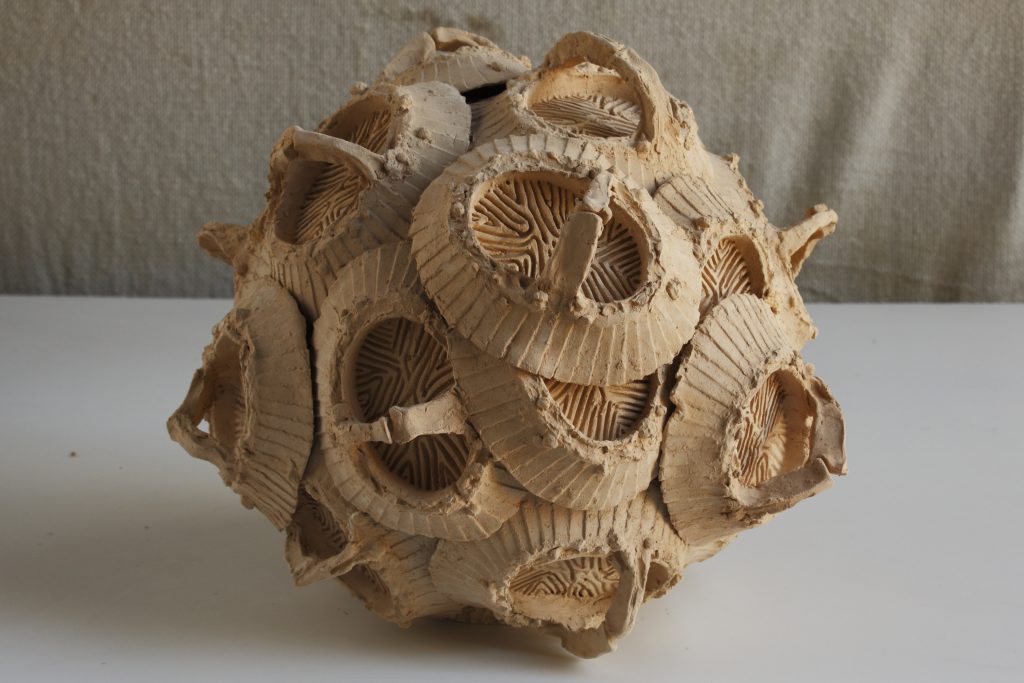
Barbara De Ponti, Clay Time Code, Gephyrocapsa Oceanica, S1, 2016
PAZ – The contribution that geology, the modern systematic study of earth sciences, has given to human understanding has been to broaden the time reference scale: scientifically it is no longer linked to the relationship with the length of a human lifespan; this makes us understand, for example, the approximately four thousand five hundred million years which is the estimated age of the Earth. So humanity is no longer the yardstick, but the one who studies and chooses the language to communicate the results of this study. It seems to me that both concepts are addressed in Clay Time Code.
BDP – I quote the art historian Alessandro Castiglioni in the conversation he had with you and which completes the investigations exhibited at the Carlo Zauli Museum in Faenza: “There is a sort of competition in the construction of content, given in part by we who look at the work and in part by the reasons with which the work was born; this project was created to stimulate reflection on what we can say about time and how much these tiny, very ancient and extinct organisms can say about us”.
“There is a sort of competition in the construction of content, given in part by we who look at the work and in part by the reasons with which the work was born; this project was created to stimulate reflection on what we can say about time and how much these tiny, very ancient and extinct organisms can say about us”.
With paleontologists we selected a foraminifera celled planktonic algae and the Globorotalia puncticulata the Gephyrocapsa Oceanica, both extinct. Through images taken under a scanning microscope, I was able to reproduce in three dimensions the organisms that determine the beginning and end of the geological period in which the clays settled and to do so using the clays that contain them. Sculptures of more than one metre have become large simulacra of the microscopic organisms. The human mind always asks itself questions concerning what is outside itself, but the pointer I would like to come from this work is to limit anthropocentrism.
The human mind always asks itself questions concerning what is outside itself,
but the pointer I would like to come from this work is to limit anthropocentrism.
The work addresses absolute questions; it was also the basis for a conversation on the value of form with the artist Jens Risch in an exhibition promoted and organized by the Viasaterna Gallery in Milan, but it could only be carried out in Faenza, and not solely for a geological issue.
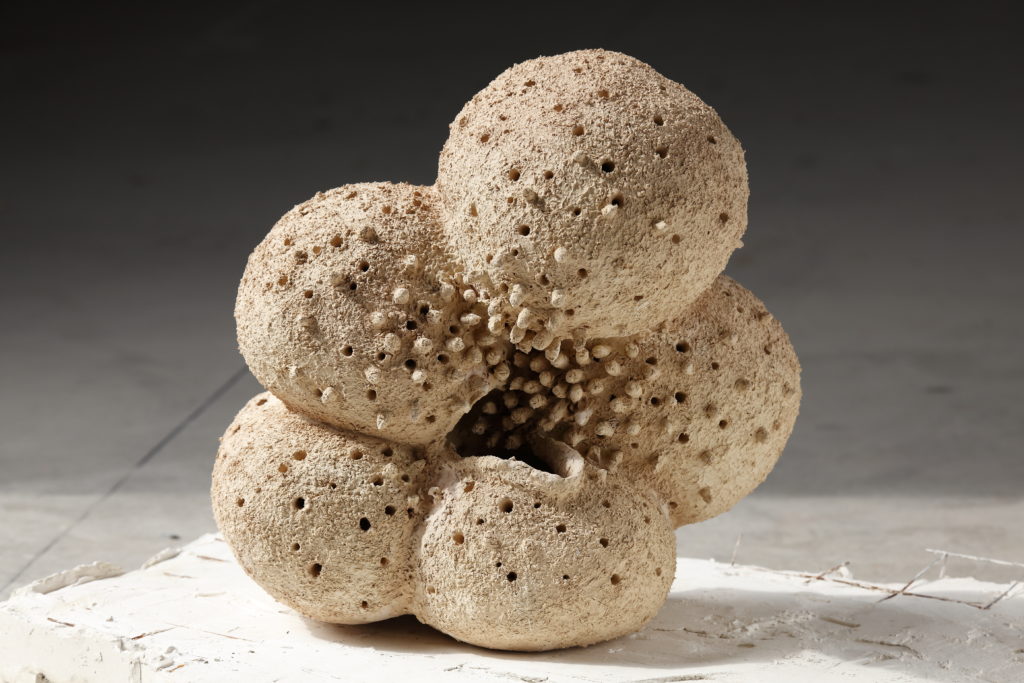
Barbara De Ponti, Clay Time Code, Globorotalia Puncticulata, S1, 20016
PAZ – The marker fossils you have chosen pick out a correlation with the absolute dating of chronological time in the environment where these fossils have lived and have remained preserved. It is no coincidence that an exhibition venue for the project was the Malmerendi Natural Science Museum in Faenza. In particular, this collection of fossils from local ravines is a real time capsule that tells the ancient and marine nature of these organisms. The museum preserves and still collects evidence of the Plio-Pleistocene sea that covered the territory whose seabed, after tectonic evolutions, would be observed and described by Leonardo da Vinci in the early sixteenth century with the term Blue Clays – which is still in use today – as we can read in the Leichester codex. The relationship with the region was also a close one thanks to the conference organized at the same time by the Anepla association and the Order of Geologists of Emilia Romagna entitled Clays: a resource amid art and region, hosted by the International Museum of Ceramics. The topics covered are strongly intertwined with what is put forward by Clay Time Code, which shows how much the experience of art can be poured into our everyday experience if we leave codified linguistic structures behind. And then we have valuable new friendships.
BDP – They are the amazing ceramists who allowed our ideas to materialize into objects of great beauty and technical complexity, Aida Bertozzi and Ceramiche Sottosasso by Lorella Morgantini and Marco Malavolti. In a very professional way they embraced the aims of the project and then adopted us too.
They are the amazing ceramists who allowed our ideas
to materialize into objects of great beauty and technical complexity,
Aida Bertozzi and Ceramiche Sottosasso by Lorella Morgantini and Marco Malavolti.
In a very professional way they embraced the aims of the project
and then adopted us too.
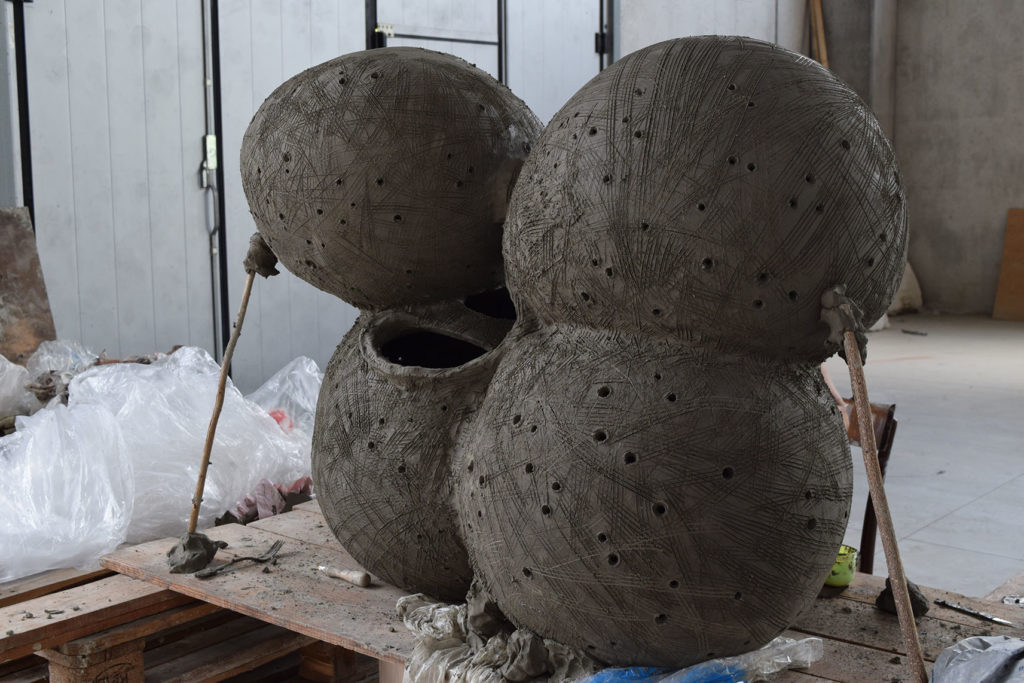
Barbara De Ponti, Clay Time Code, Globorotalia Puncticulata, 2016, In Fieri

